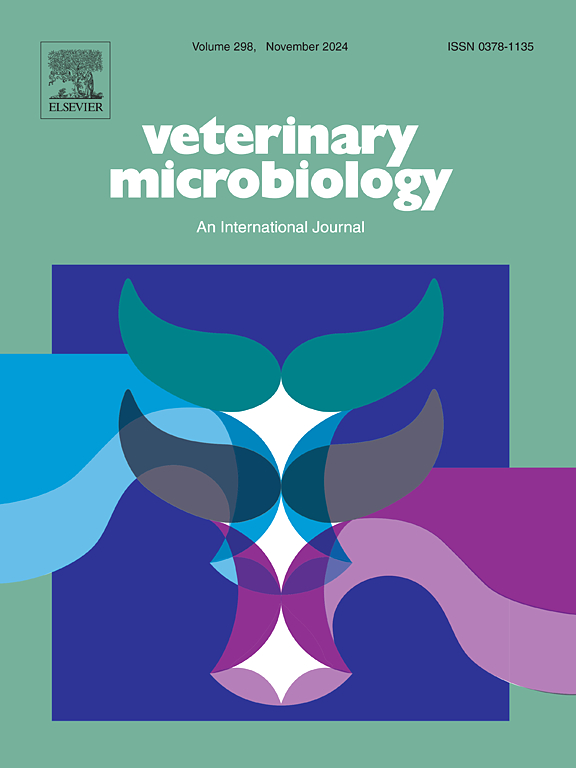2006-2018年中国多源阿奇霉素耐药非伤寒沙门氏菌多药耐药情况及基因组分析
IF 2.7
2区 农林科学
Q3 MICROBIOLOGY
引用次数: 0
摘要
阿奇霉素通常被推荐用于治疗侵袭性沙门氏菌病,尽管阿奇霉素耐药性的出现已成为一个新的公共卫生问题,但在中国很少进行调查。本研究分析了2006-2018年中国不同来源的1230株非伤寒沙门氏菌(NTS),从鸡、猪肉和人中分离出101株阿奇霉素耐药NTS, 7种血清型中阿奇霉素的最小抑制浓度(MIC)值为32-64 μg/mL,主要是ST17 S. Indiana( = 68)和ST52 S. Blockley( = 26)。耐阿奇霉素NTS菌株均呈现多药耐药模式,其中48株对9种抗生素耐药。基因组分析发现六种不同的大环内酯物抗性基因在azithromycin-resistant nt隔离:英里(A) (n = 94),英里/小时(E) msr (E) (n = 4),汇率机制(42)(n = 2),汇率机制(G) (n = 1)和erm (T) (n = 1)。mph(A)(93.07 %)在遗传环境mph(A)-mrx-mphR(A)-IS6100中最为普遍。23S rRNA基因和50S核糖体蛋白L22和L4编码序列未发现与阿奇霉素耐药相关的突变。共鉴定出22个不同的质粒复制子,其中IncX1最为普遍(58.42 %,59/101)。值得注意的是,所有ST52 S. Blockley菌株(n = 26)的mph(A)基因均位于染色体上。相比之下,其他六种血清型的mph(A)和erm(42), erm(T), mph(E)-msr(E)预测在质粒上。具体来说,erm(T)基因与IncQ1质粒相关。这些发现强调了在整个食物链中持续监测NTS中阿奇霉素耐药性的必要性,以更好地了解和减轻其潜在的公共卫生影响。本文章由计算机程序翻译,如有差异,请以英文原文为准。
Emergence of multidrug resistance and genomic analysis of azithromycin-resistant non-typhoidal Salmonella from diverse sources in China, 2006–2018
Azithromycin is commonly recommended for the treatment of invasive salmonellosis, although the emergence of azithromycin resistance has become a new public health issue, it was seldomly investigated in China. This study analyzed 1230 non-typhoidal Salmonella (NTS) isolates from diverse sources in China (2006–2018), identifying 101 azithromycin-resistant NTS isolated from chicken, pork and human with minimum inhibitory concentration (MIC) values of 32–64 μg/mL of azithromycin across seven serotypes, primarily ST17 S. Indiana (n = 68) and ST52 S. Blockley (n = 26). All azithromycin-resistant NTS isolates exhibited multidrug resistance pattern with 48 isolates exhibited resistance to nine antibiotic categories. Genomic analysis identified six kinds of distinct macrolide resistance genes in azithromycin-resistant NTS isolates: mph(A) (n = 94), mph(E)-msr(E) (n = 4), erm(42) (n = 2), erm(G) (n = 1) and erm(T) (n = 1). mph(A) (93.07 %) was most prevalent and found within the genetic environment mph(A)-mrx-mphR(A)-IS6100. No mutation associated with azithromycin resistance was discovered in the 23S rRNA gene, and 50S ribosomal protein L22 and L4 encoding sequences. A total of 22 distinct plasmid replicons were identified, with IncX1 being the most prevalent (58.42 %, 59/101). Notably, mph(A) gene in all ST52 S. Blockley strains (n = 26) were exclusively located on the chromosome. In contrast, mph(A) in other six serotypes, and erm(42), erm(T), mph(E)-msr(E) were predicted to be on plasmids. Specifically, the erm(T) gene was associated with IncQ1 plasmids. These findings underscore the necessity of continuous surveillance of azithromycin resistance in NTS across the food chain to better understand and mitigate its potential public health impact.
求助全文
通过发布文献求助,成功后即可免费获取论文全文。
去求助
来源期刊

Veterinary microbiology
农林科学-兽医学
CiteScore
5.90
自引率
6.10%
发文量
221
审稿时长
52 days
期刊介绍:
Veterinary Microbiology is concerned with microbial (bacterial, fungal, viral) diseases of domesticated vertebrate animals (livestock, companion animals, fur-bearing animals, game, poultry, fish) that supply food, other useful products or companionship. In addition, Microbial diseases of wild animals living in captivity, or as members of the feral fauna will also be considered if the infections are of interest because of their interrelation with humans (zoonoses) and/or domestic animals. Studies of antimicrobial resistance are also included, provided that the results represent a substantial advance in knowledge. Authors are strongly encouraged to read - prior to submission - the Editorials (''Scope or cope'' and ''Scope or cope II'') published previously in the journal. The Editors reserve the right to suggest submission to another journal for those papers which they feel would be more appropriate for consideration by that journal.
Original research papers of high quality and novelty on aspects of control, host response, molecular biology, pathogenesis, prevention, and treatment of microbial diseases of animals are published. Papers dealing primarily with immunology, epidemiology, molecular biology and antiviral or microbial agents will only be considered if they demonstrate a clear impact on a disease. Papers focusing solely on diagnostic techniques (such as another PCR protocol or ELISA) will not be published - focus should be on a microorganism and not on a particular technique. Papers only reporting microbial sequences, transcriptomics data, or proteomics data will not be considered unless the results represent a substantial advance in knowledge.
Drug trial papers will be considered if they have general application or significance. Papers on the identification of microorganisms will also be considered, but detailed taxonomic studies do not fall within the scope of the journal. Case reports will not be published, unless they have general application or contain novel aspects. Papers of geographically limited interest, which repeat what had been established elsewhere will not be considered. The readership of the journal is global.
 求助内容:
求助内容: 应助结果提醒方式:
应助结果提醒方式:


